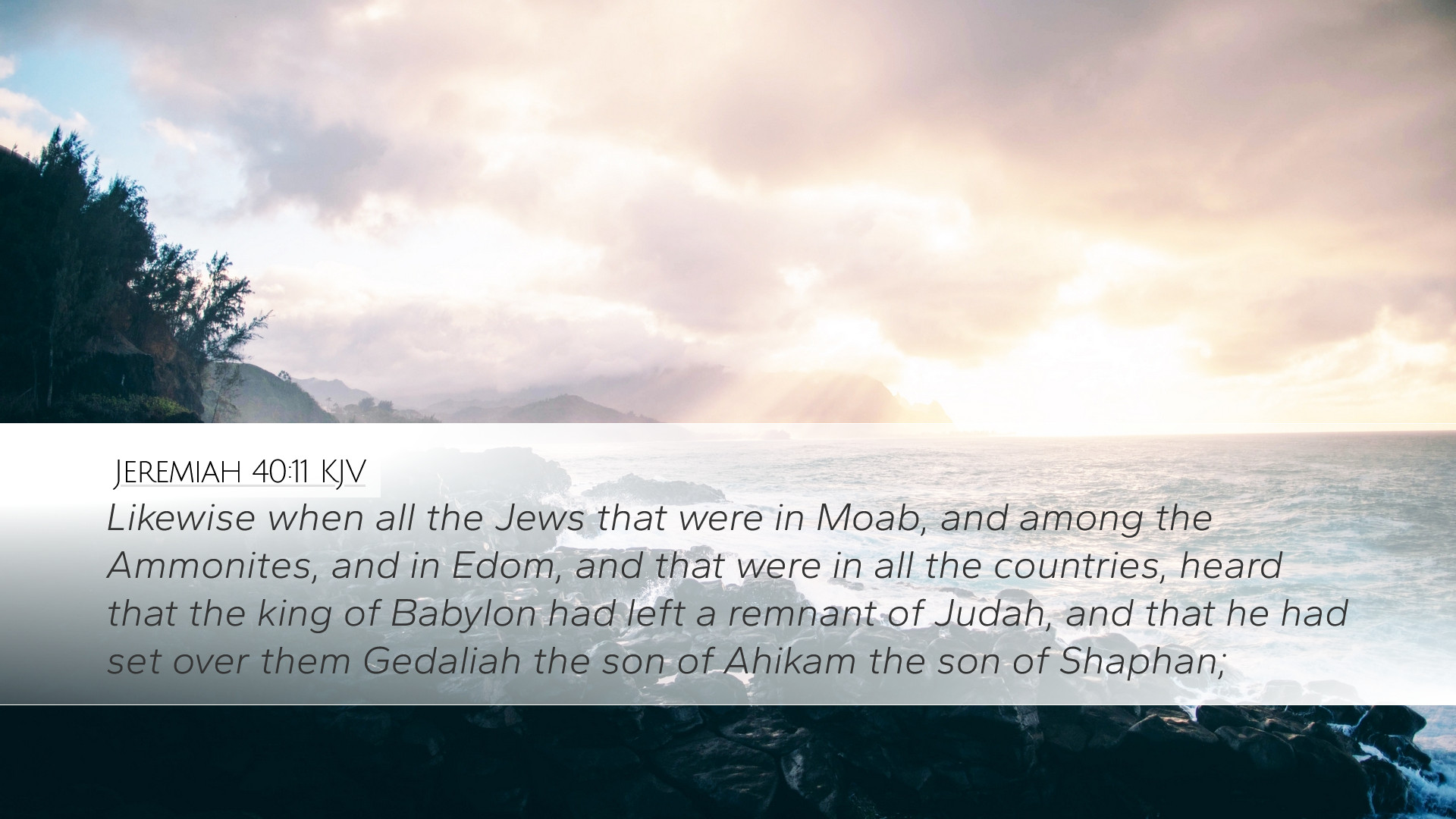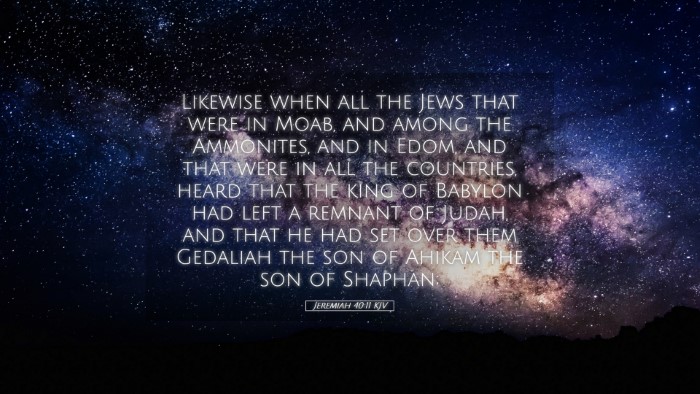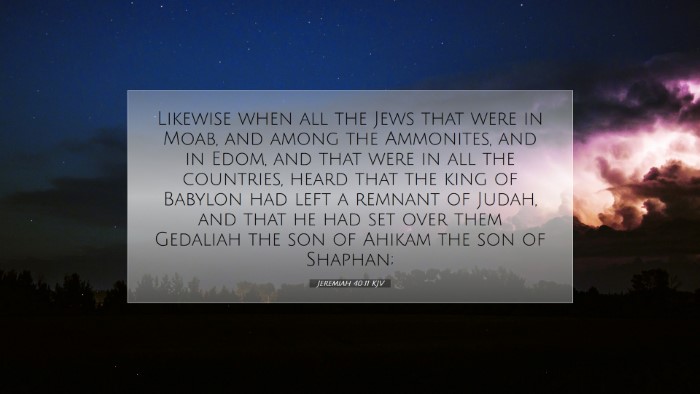Commentary on Jeremiah 40:11
Jeremiah 40:11 states:
"Likewise, when all the Jews who were in Moab, among the Ammonites, and in Edom, and that were in all the countries, heard that the king of Babylon had left a remnant of Judah, and that he had set over them Gedaliah the son of Ahikam the son of Shaphan;"
Context and Background
This verse falls within the larger narrative of the book of Jeremiah, which is focused on the prophecies and experiences of the prophet Jeremiah during the tumultuous period surrounding the Babylonian exile. After the fall of Jerusalem, Gedaliah was appointed governor over the remnant of the people left in Judah. This moment was one of hope and restoration amidst devastation.
Thematic Insights
The themes emerging from Jeremiah 40:11 involve divine sovereignty, restoration, and the dynamics of hope versus despair. The knowledge that Babylon left a remnant is significant for the people of Judah, reflecting God’s enduring commitment to His covenant people.
Divine Sovereignty and Human Agency
According to Matthew Henry, God's sovereignty is evident in the appointment of Gedaliah, which demonstrates His hand in guiding the remnants of Judah. Although Babylon’s conquest resulted in significant suffering, God’s purpose prevails as He orchestrates leadership for His people.
In contrast, Albert Barnes emphasizes the responsibility of the Jewish people in this new reality. They must respond faithfully to Gedaliah's leadership to ensure their survival and restoration.
The Hope of Restoration
This verse reflects a pivotal moment of hope. The Jews in surrounding nations learn of Gedaliah’s appointment and the potential for rebuilding their homeland. Adam Clarke notes that the whisper of hope spreads among the scattered Jews, highlighting that even amid ruin, God can stir the hearts of His people toward return and restoration.
Historical Context
The backdrop of this passage includes the destruction wrought by the Babylonian Empire. The various nations mentioned (Moab, Ammon, and Edom) symbolize the places where the Jews had been exiled. The return of some to Judah under Gedaliah represents a significant shift in the power dynamics of the region.
The Role of Gedaliah
Gedaliah's role is crucial. Matthew Henry depicts him as a well-chosen leader—a figure of hope following chaos. His leadership represents not merely political authority but a spiritual opportunity for the remnant to align themselves once again with God’s purpose.
Albert Barnes adds an important note about the significance of Gedaliah’s lineage, tracing it back to the Shaphan family, a family noted for its ties to prophetic tradition. This connection underscores the spiritual continuity amidst chaos.
The Remnant's Response
The core of this narrative invites reflection upon the response of the remnant. The Jews’ mixed sentiments illustrate the complexities of faith and fear. Adam Clarke highlights that their return is laden with uncertainty, which requires faith in God’s promise for a future restoration.
Reactions Among the Exiles
The movement of Jews from foreign lands back to Judah signifies a significant act of faith. As they hear the news, they are faced with choices: to return and face potential peril or to remain in exile's safety. This duality reflects a profound spiritual truth regarding trust in God.
Matthew Henry encourages recognition of divine providence in their decision-making process—highlighting that God inspires hearts to action, illuminating paths back to Him and His promises.
Applications for Today
For today's pastors, students, theologians, and Bible scholars, Jeremiah 40:11 serves as a powerful reminder of God’s persistent grace and the sovereignty that guides history toward His planned restoration. It challenges contemporary readers to consider their responses to divine signals of hope in their lives.
Lessons on Leadership
The example of Gedaliah invites reflection on the qualities of godly leadership. It presents questions about how spiritual leaders guide those entrusted to them amidst uncertainties and how they reflect God's mercy and purpose.
Hope in Despair
This passage reassures believers that even in devastation, there exists a thread of hope woven through God’s promises. Albert Barnes encourages today’s faithful to trust in God’s ability to bring restoration and renewal even when circumstances seem dire.
Conclusion
Jeremiah 40:11 encapsulates a profound moment of transition for the people of Judah. Through the insights of public domain commentaries, we grasp the depth of theological reflection, historical significance, and practical applications. As God’s sovereignty guides the remnants back, it invites all believers to embrace the hope of restoration and faith amid uncertainty.


